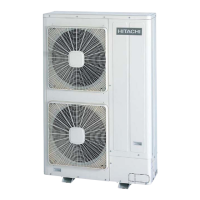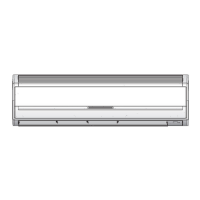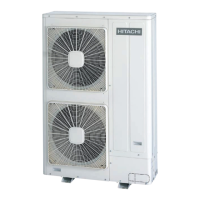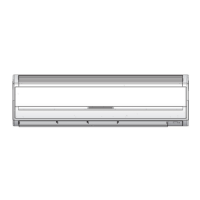Do you have a question about the Hitachi RAS-8FS3 and is the answer not in the manual?
Basic troubleshooting steps including switch settings and electrical wiring checks.
Systematic diagnosis using alarm codes and check modes.
Detailed checks for individual components and PCBs.
Procedures for verifying system operation after installation or repair.
Procedures for servicing and disassembling outdoor unit components.
Specific servicing steps for RPI In-the-Ceiling models.
Servicing procedures for larger RPI In-the-Ceiling models.
Servicing procedures for 4-Way Cassette type indoor units.
Servicing procedures for 2-Way Cassette type indoor units.
Servicing procedures for Wall Type indoor units.
Servicing procedures for Floor Type indoor units.
Servicing procedures for Floor Concealed type indoor units.
Servicing procedures for Ceiling Type indoor units.
Information about the structure and parts of the total heat exchanger.
Detailed steps for cleaning indoor unit heat exchangers.
Procedures for collecting refrigerant for indoor unit replacement.
Details on inverter specifications, protection, and control functions.
Explanation of AC Chopper control for fan speed and its specifications.
Description of the auto-louver mechanism for various cassette types.
Details on scroll compressor mechanism, structure, and types.
Information on thermistors used in indoor and outdoor units.
Specifications and operation of electronic expansion valves.
Details on high and low pressure sensor functions and characteristics.
Explanation of the high pressure protection device and its circuit.
Information on the noise filter's purpose and specifications.
Specifications for capacitors used in the inverter.
Specifications for the reactor (DCL) used in the inverter.
Details on optional functions for various indoor unit types.
Optional functions for specific indoor unit models.
External signal inputs and outputs for outdoor unit control.
Overview and naming of parts for remote control switches.
Components and naming of the wireless remote control switch.
Usage and self-checking procedures for the 7-day timer.
Overview and operation of the central station control unit.
Basic troubleshooting steps including switch settings and electrical wiring checks.
Systematic diagnosis using alarm codes and check modes.
Table listing alarm codes and their leading causes.
Using remote control for PCB diagnosis and data checking.
Using the outdoor unit's 7-segment display for troubleshooting.
Explains the function of rotary switches, dip switches, and LEDs on PCBs.
Performing PCB self-checks using the remote control.
Procedures for self-checking the remote control switch functions.
Self-checking procedures for indoor unit PCBs.
Self-checking steps for the 7-day timer unit.
Self-checking procedures for the central station.
High voltage discharge work and checks for other main parts.
Checklist for diagnosing compressor issues and connections.
Procedure for performing test run using the remote control.
Procedure for performing test run using the outdoor unit dip switches.
Checklist for test operation and sampling data for FSG/FS3 series.
Procedures for servicing and disassembling outdoor unit components.
Specific servicing steps for RPI In-the-Ceiling models.
Servicing procedures for larger RPI In-the-Ceiling models.
Servicing procedures for 4-Way Cassette type indoor units.
Servicing procedures for 2-Way Cassette type indoor units.
Servicing procedures for Wall Type indoor units.
Servicing procedures for Floor Type indoor units.
Servicing procedures for Floor Concealed type indoor units.
Servicing procedures for Ceiling Type indoor units.
Information about the structure and parts of the total heat exchanger.
Detailed steps for cleaning indoor unit heat exchangers.
Procedures for collecting refrigerant for indoor unit replacement.
Details on inverter specifications, protection, and control functions.
Explanation of AC Chopper control for fan speed and its specifications.
Description of the auto-louver mechanism for various cassette types.
Details on scroll compressor mechanism, structure, and types.
Information on thermistors used in indoor and outdoor units.
Specifications and operation of electronic expansion valves.
Details on high and low pressure sensor functions and characteristics.
Explanation of the high pressure protection device and its circuit.
Information on the noise filter's purpose and specifications.
Specifications for capacitors used in the inverter.
Specifications for the reactor (DCL) used in the inverter.
Details on optional functions for various indoor unit types.
Optional functions for specific indoor unit models.
External signal inputs and outputs for outdoor unit control.
Overview and naming of parts for remote control switches.
Components and naming of the wireless remote control switch.
Usage and self-checking procedures for the 7-day timer.
Overview and operation of the central station control unit.
Troubleshooting example of compressor failure due to low refrigerant.
Diagnosing and resolving cooling issues with long piping installations.
Troubleshooting high operating sound in ceiling type units.
Troubleshooting steps for Alarm Code "31" related to unit combination.
Addressing cooling issues caused by inadequate outdoor unit installation space.
Important considerations for FXG/FX3 series installation and operation.
Guidelines on piping length for farthest indoor units.
Considerations for starting up in simultaneous COOL/HEAT mode.
Precautions for automatic COOL/HEAT operation.
Important considerations for installing CH units.
Guide for selecting appropriate drain pipe diameters based on flow volume.
Safety precautions and calculations regarding refrigerant concentration and leakage.
General maintenance checks for indoor and outdoor units.
Data sheet for recording service and maintenance using the 7-segment display.
Data sheet for recording service and maintenance via remote control.
General service and maintenance record log.
Diagram showing the location of key parts in outdoor units.
Detailed refrigerant cycle diagram and component list for a specific model.
Basic troubleshooting steps including switch settings and electrical wiring checks.
Systematic diagnosis using alarm codes and check modes.
Detailed checks for individual components and PCBs.
Procedures for verifying system operation after installation or repair.
Procedures for servicing and disassembling outdoor unit components.
Specific servicing steps for RPI In-the-Ceiling models.
Servicing procedures for larger RPI In-the-Ceiling models.
Servicing procedures for 4-Way Cassette type indoor units.
Servicing procedures for 2-Way Cassette type indoor units.
Servicing procedures for Wall Type indoor units.
Servicing procedures for Floor Type indoor units.
Servicing procedures for Floor Concealed type indoor units.
Servicing procedures for Ceiling Type indoor units.
Information about the structure and parts of the total heat exchanger.
Detailed steps for cleaning indoor unit heat exchangers.
Procedures for collecting refrigerant for indoor unit replacement.
Details on inverter specifications, protection, and control functions.
Explanation of AC Chopper control for fan speed and its specifications.
Description of the auto-louver mechanism for various cassette types.
Details on scroll compressor mechanism, structure, and types.
Information on thermistors used in indoor and outdoor units.
Specifications and operation of electronic expansion valves.
Details on high and low pressure sensor functions and characteristics.
Explanation of the high pressure protection device and its circuit.
Information on the noise filter's purpose and specifications.
Specifications for capacitors used in the inverter.
Specifications for the reactor (DCL) used in the inverter.
Details on optional functions for various indoor unit types.
Optional functions for specific indoor unit models.
External signal inputs and outputs for outdoor unit control.
Overview and naming of parts for remote control switches.
Components and naming of the wireless remote control switch.
Usage and self-checking procedures for the 7-day timer.
Overview and operation of the central station control unit.
Basic troubleshooting steps including switch settings and electrical wiring checks.
Systematic diagnosis using alarm codes and check modes.
Table listing alarm codes and their leading causes.
Using remote control for PCB diagnosis and data checking.
Using the outdoor unit's 7-segment display for troubleshooting.
Explains the function of rotary switches, dip switches, and LEDs on PCBs.
Performing PCB self-checks using the remote control.
Procedures for self-checking the remote control switch functions.
Self-checking procedures for indoor unit PCBs.
Self-checking steps for the 7-day timer unit.
Self-checking procedures for the central station.
High voltage discharge work and checks for other main parts.
Checklist for diagnosing compressor issues and connections.
Procedure for performing test run using the remote control.
Procedure for performing test run using the outdoor unit dip switches.
Checklist for test operation and sampling data for FSG/FS3 series.
Procedures for servicing and disassembling outdoor unit components.
Specific servicing steps for RPI In-the-Ceiling models.
Servicing procedures for larger RPI In-the-Ceiling models.
Servicing procedures for 4-Way Cassette type indoor units.
Servicing procedures for 2-Way Cassette type indoor units.
Servicing procedures for Wall Type indoor units.
Servicing procedures for Floor Type indoor units.
Servicing procedures for Floor Concealed type indoor units.
Servicing procedures for Ceiling Type indoor units.
Information about the structure and parts of the total heat exchanger.
Detailed steps for cleaning indoor unit heat exchangers.
Procedures for collecting refrigerant for indoor unit replacement.
Details on inverter specifications, protection, and control functions.
Explanation of AC Chopper control for fan speed and its specifications.
Description of the auto-louver mechanism for various cassette types.
Details on scroll compressor mechanism, structure, and types.
Information on thermistors used in indoor and outdoor units.
Specifications and operation of electronic expansion valves.
Details on high and low pressure sensor functions and characteristics.
Explanation of the high pressure protection device and its circuit.
Information on the noise filter's purpose and specifications.
Specifications for capacitors used in the inverter.
Specifications for the reactor (DCL) used in the inverter.
Details on optional functions for various indoor unit types.
Optional functions for specific indoor unit models.
External signal inputs and outputs for outdoor unit control.
Overview and naming of parts for remote control switches.
Components and naming of the wireless remote control switch.
Usage and self-checking procedures for the 7-day timer.
Overview and operation of the central station control unit.
Troubleshooting example of compressor failure due to low refrigerant.
Diagnosing and resolving cooling issues with long piping installations.
Troubleshooting high operating sound in ceiling type units.
Troubleshooting steps for Alarm Code "31" related to unit combination.
Addressing cooling issues caused by inadequate outdoor unit installation space.
Important considerations for FXG/FX3 series installation and operation.
Guidelines on piping length for farthest indoor units.
Considerations for starting up in simultaneous COOL/HEAT mode.
Precautions for automatic COOL/HEAT operation.
Important considerations for installing CH units.
Guide for selecting appropriate drain pipe diameters based on flow volume.
Safety precautions and calculations regarding refrigerant concentration and leakage.
General maintenance checks for indoor and outdoor units.
Data sheet for recording service and maintenance using the 7-segment display.
Data sheet for recording service and maintenance via remote control.
General service and maintenance record log.
Diagram showing the location of key parts in outdoor units.
Detailed refrigerant cycle diagram and component list for a specific model.
| Type | Split System |
|---|---|
| Cooling Capacity | 2.5 kW |
| Heating Capacity | 2.8 kW |
| Power Supply | 220-240V, 50Hz |
| Refrigerant | R410A |
| Indoor Unit Weight | 9 kg |
| Noise Level (Outdoor) | 50 dB(A) |












